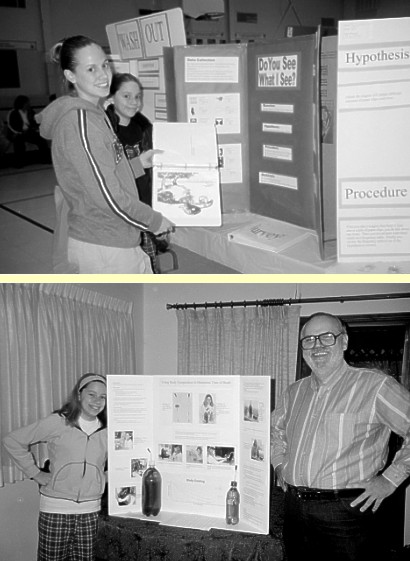
Snapshots by Gloria Freeland - March 4, 2004
Hypothesis: this year's science fair would be better than ever!
The experiments the students at Riley County Grade School come up with each year for the science fair amaze me. When I was in grade school, I don't think I would have known what a hypothesis was if it had jumped up and bitten me!
As the girls and I made our way around the gym where the science displays were set up last Friday, the thing that struck me was the variety.
One display showed how to identify different types of leaves. Another compared the amount of bacteria on door handles at different fast-food establishments in town. Still another tested whether males and females would see optical illusions differently. Miniature bridges, crystals, an automatic banana peeler and tools submerged in cola were among the hundreds of displays set up on the tables.
I could only imagine how many hours were invested in the experiments. I knew Katie spent days working on hers. Although she was pleased with the outcome and what she had learned, she was also relieved that all that work was behind her.
Katie's interest in archaeology has prompted her to do demonstrations and experiments related to that field. Two years ago, she constructed a volcano and explained what happened when Vesuvius erupted, burying Pompeii and its inhabitants. Last year, her experiment demonstrated what happens to apples, pears and oranges when they are covered with a mixture of salt and baking soda - a mixture used by the Egyptians in the mummification process.
This year, she decided to do an experiment related to her interest in archaeology and the TV show, "CSI: Crime Scene Investigations." One aspect she was curious about was how investigators on the show could determine time of death by sticking a temperature probe into a dead person's liver.
Since Art is a scientist, he answered Katie's questions about energy, work, force, atoms and heat. She went to her own science book when his explanations got too technical for her. She decided to use body temperature to determine time of death of two bodies - Big Blue, a two-liter bottle filled with water dyed with blue food coloring, and Baby Blue, a 500 milliliter bottle, also filled with blue-colored water.
After Art showed her how to strip wires and solder leads on the sensors that would be used to measure temperatures of the Blue family, Katie stripped and soldered. The sensors were threaded into the "heads" - caps - of Big and Baby and then sealed. Katie warmed the Blues in an electric skillet and the process began.
The temperatures of the "bodies" were measured at five- and 10-minute intervals as they cooled and then were recorded and graphed. The question was whether the time of "death" could be accurately predicted. Katie's hypothesis that the time of death could be predicted using body temperatures turned out to be correct.
It wasn't all as simple as that, though. Katie went through a frustrating time when the sensors acted up and data had to be scrapped and the process started again. Watching her move through that frustration made me appreciate even more the work that scientists do and the patience they must have to persist in their studies.
It was nice to see that Katie appreciated my contribution to her scientific study. There, at the end of her poster, was my name among the "thank yous" - to Art for his technical help and Mom for the use of her electric frying pan and her home for the scene of the Blue family's demise. Mine was for bringing lunch!

Mariya and Katie, top photo, check out optical illusions.
Scientists Katie and Art, bottom photo, next to her �CSI� experiment.